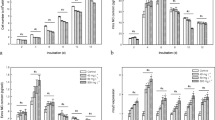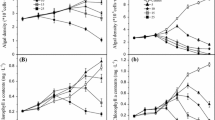Abstract
This investigation demonstrates that programmed cell death (PCD) in a cyanobacterium, Microcystis aeruginosa, resulting from allelopathic stress induced by a submerged macrophyte, Myriophyllum spicatum, in a co-culture system. The hallmarks of PCD, caspase-3-like protease activity, DNA fragmentation, and destruction of cell ultrastructure, as well as intracellular PCD signaling radicals, reactive oxygen species (ROS), and nitric oxide (NO), were measured in M. aeruginosa cells co-cultured with M. spicatum for 7 days. The results showed a dose–response relationship between M. spicatum biomass and M. aeruginosa mortality. A caspase-3-like protease was activated and elevated from day 3. Thylakoid disintegration, cytoplasmic vacuolation, and fuzzy nuclear zone were observed by transmission electron microscopy, and distinct DNA fragmentation was detected in M. aeruginosa cells at a M. spicatum biomass of 6.0 g fresh weight (FW) L−1 during the 7 days. Allelochemicals of total phenolic compounds (TPCs) were determined in co-culture water, and the concentration increased with increasing of M. spicatum biomass and co-culture time. Compared with the level of ROS production in the control group, a significant overproduction of ROS was detected in M. aeruginosa cells in the treatment group, and this was positively correlated with TPC concentration. Furthermore, the level of intracellular NO increased with the percent mortality of M. aeruginosa. The results indicated that a PCD pathway was induced in the cyanobacterium M. aeruginosa when co-cultured with the submerged macrophyte M. spicatum.








Similar content being viewed by others
References
Affenzeller MJ, Darehshouri A, Andosch A, Lütz C, Lütz-Meindl U (2009) Salt stress-induced cell death in the unicellular green alga Micrasterias denticulata. J Exp Bot 60:939–954
Aleksandrushkina N, Vanyushin B (2009) Endonucleases and their involvement in plant apoptosis. Russ J Plant Physiol 56:291–305
Ameisen JC (1996) The origin of programmed cell death. Science 272:1278–1279
Ameisen JC (2002) On the origin, evolution, and nature of programmed cell death: a timeline of four billion years. Cell Death Differ 9(4):367–393
Arasimowicz-Jelonek M, Floryszak-Wieczorek J, Deckert J, Rucińska-Sobkowiak R, Gzyl J, Pawlak-Sprada S, Abramowski D, Jelonek T, Gwóźdź EA (2012) Nitric oxide implication in cadmium-induced programmed cell death in roots and signaling response of yellow lupine plants. Plant Physiol Biochem 58:124–134
Ben El Hadj Ali I, Bahri R, Chaouachi M, Boussaïd M, Harzallah-Skhiri F (2014) Phenolic content, antioxidant and allelopathic activities of various extracts of Thymus numidicus Poir. organs. Ind Crops Prod 62:188–195
Berman-Frank I, Bidle KD, Haramaty L, Falkowski PG (2004) The demise of the marine cyanobacterium, Trichodesmium spp., via an autocatalyzed cell death pathway. Limnol Oceanogr 49:997–1005
Bhattacharjee S (2005) Reactive oxygen species and oxidative burst: roles in stress, senescence and signal. Curr Sci 89:1113–1121
Bradford MM (1976) A rapid and sensitive method for the quantitation of microgram quantities of protein utilizing the principle of protein-dye binding. Anal Biochem 72:248–254
Brockhaus F, Brüne B (1998) U937 apoptotic cell death by nitric oxide: Bcl-2 downregulation and caspase activation. Exp Cell Res 238:33–41
Casotti R, Mazza S, Brunet C, Vantrepotte V, Ianora A, Miralto A (2005) Growth inhibition and toxicity of the diatom aldehyde 2-trans, 4-trans-decadienal on Thalassiosira weissflogii (Bacillariophyceae). J Phycol 41:7–20
Choi C, Berges J (2013) New types of metacaspases in phytoplankton reveal diverse origins of cell death proteases. Cell Death Dis 4(2):e490
Clarke A, Desikan R, Hurst RD, Hancock JT, Neill SJ (2000) NO way back: nitric oxide and programmed cell death in Arabidopsis thaliana suspension cultures. Plant J 24:667–677
Darehshouri A, Affenzeller M, Lütz-Meindl U (2008) Cell death upon H2O2 induction in the unicellular green alga Micrasterias. Plant Biol 10:732–745
Ding Y, Gan N, Li J, Sedmak B, Song L (2012) Hydrogen peroxide induces apoptotic-like cell death in Microcystis aeruginosa (Chroococcales, Cyanobacteria) in a dose-dependent manner. Phycologia 51:567–575
Einhellig F, Galindo J, Molinillo J, Cutler H (2004) Mode of allelochemical action of phenolic compounds. In: Macìas FA, Galindo JCG, Molinillo JMG, Cutler HG (eds) Allelopathy: chemistry and mode of action of allelochemicals. CRC Press, London, pp 217–238
Hemnani T, Parihar M (1998) Reactive oxygen species and oxidative DNA damage. Indian J Physiol Pharmacol 42:440–452
Hilt S, Gross EM (2008) Can allelopathically active submerged macrophytes stabilise clear-water states in shallow lakes? Basic Appl Ecol 9:422–432
Hong Y, Hu HY, Xie X, Sakoda A, Sagehashi M, Li FM (2009) Gramine-induced growth inhibition, oxidative damage and antioxidant responses in freshwater cyanobacterium Microcystis aeruginosa. Aquat Toxicol 91:262–269
Hong Y, Hu H, Sakoda A, Sagehashi M (2010) Effects of allelochemical gramine on metabolic activity and ultrastructure of cyanobacterium Microcystis aeruginosa. World Acad Sci Eng Technol 47:826–830
Janeiro P, Brett AMO (2004) Catechin electrochemical oxidation mechanisms. Anal Chim Acta 518:109–115
Jensen TE (1993) Cyanobacterial ultrastructure. In: Berner T (ed) Ultrastructure of microalgae. CRC, Boca Raton, pp 7–51
Kim YM, Talanian RV, Billiar TR (1997) Nitric oxide inhibits apoptosis by preventing increases in caspase-3-like activity via two distinct mechanisms. J Biol Chem 272:31138–31148
Klemenčič M, Novinec M, Dolinar M (2015) Orthocaspases are proteolytically active prokaryotic caspase homologues: the case of Microcystis aeruginosa. Mol Microbiol 98:142–150
Kondo K, Kurihara M, Miyata N, Suzuki T, Toyoda M (1999) Scavenging mechanisms of (−)-epigallocatechin gallate and (−)-epicatechin gallate on peroxyl radicals and formation of superoxide during the inhibitory action. Free Radic Biol Med 27:855–863
Körner S, Nicklisch A (2002) Allelopathic growth inhibition of selected phytoplankton species by submerged macrophytes. J Phycol 38:862–871
Long LH, Clement MV, Halliwell B (2000) Artifacts in cell culture: rapid generation of hydrogen peroxide on addition of (−)-epigallocatechin, (−)-epigallocatechin gallate, (+)-catechin, and quercetin to commonly used cell culture media. Biochem Biophys Res Commun 273:50–53
Ma JM, Cheng SP, He F, Zuo JC, Zhao Q, Zhang Z, Wu J, Wu ZB (2009) Practice and implication of establishing aquatic vegetation in Lake Yuehu in Wuhan, China. Acta Hydrobiologica Sinica 33:222–229
Makino F, Tsuzuki J (1971) Absence of histone in the blue-green alga Anabaena cylindrica. Nature 231:446–447
Moharikar S, D’Souza JS, Kulkarni AB, Rao BJ (2006) Apoptotic-like cell death pathway is induced in unicellular chlorophyte Chlamydomonas reinhardtii (Chlorophyceae) cells following UV irradiation: detection and functional analyses. J Phycol 42:423–433
Nakai S, Inoue Y, Hosomi M, Murakami A (1999) Growth inhibition of blue-green algae by allelopathic effects of macrophytes. Water Sci Technol 39:47–53
Nakai S, Inoue Y, Hosomi M, Murakami A (2000) Myriophyllum spicatum-released allelopathic polyphenols inhibiting growth of blue-green algae Microcystis aeruginosa. Water Res 34:3026–3032
Nedelcu AM (2006) Evidence for p53-like-mediated stress responses in green algae. FEBS Lett 580:3013–3017
Nicklisch A (1992) The interaction of irradiance and temperature on the growth rate of Limnothrix redekei and its mathematical description. Arch Hydrobiol Suppl 91(Algological Studies 63):1–18
Ning SB, Guo HL, Wang L, Song YC (2002) Salt stress induces programmed cell death in prokaryotic organism Anabaena. J Appl Microbiol 93:15–28
O’Brien PJ (1991) Molecular mechanisms of quinone cytotoxicity. Chem Biol Interact 80:1–41
Rippka R, Deruelles J, Waterbury JB, Herdman M, Stanier RY (1979) Generic assignments, strain histories and properties of pure cultures of cyanobacteria. J Gen Microbiol 111:1–61
Ross C, Santiago-Vázquez L, Paul V (2006) Toxin release in response to oxidative stress and programmed cell death in the cyanobacterium Microcystis aeruginosa. Aquat Toxicol 78(1):66–73
Saeki K, Hayakawa S, Isemura M, Miyase T (2000) Importance of a pyrogallol-type structure in catechin compounds for apoptosis-inducing activity. Phytochemistry 53:391–394
Scheffer M, Hosper S, Meijer M, Moss B, Jeppesen E (1993) Alternative equilibria in shallow lakes. Trends Ecol Evol 8:275–279
Segovia M, Haramaty L, Berges JA, Falkowski PG (2003) Cell death in the unicellular chlorophyte Dunaliella tertiolecta. A hypothesis on the evolution of apoptosis in higher plants and metazoans. Plant Physiol 132:99–105
Simon HU, Haj-Yehia A, Levi-Schaffer F (2000) Role of reactive oxygen species (ROS) in apoptosis induction. Apoptosis 5:415–418
Tang X, Chen J, Wang WH, Liu TW, Zhang J, Gao YH, Pei ZM, Zheng HL (2011) The changes of nitric oxide production during the growth of Microcystis aerugrinosa. Environ Pollut 159:3784–3792
Vardi A, Formiggini F, Casotti R, De Martino A, Ribalet F, Miralto A, Bowler C (2006) A stress surveillance system based on calcium and nitric oxide in marine diatoms. PLoS Biol 4(3):e60. doi:10.1371/journal.pbio.0040060
Vardi A, Bidle KD, Kwityn C, Hirsh DJ, Thompson SM, Callow JA, Falkowski P, Bowler C (2008) A diatom gene regulating nitric-oxide signaling and susceptibility to diatom-derived aldehydes. Curr Biol 18:895–899
Wang J, Zhu J, Liu S, Liu B, Gao Y, Wu Z (2011) Generation of reactive oxygen species in cyanobacteria and green algae induced by allelochemicals of submerged macrophytes. Chemosphere 85:977–982
Warhurst BC (2014) Effects of elevated salinity and oxidative stress on the physiology of the toxigenic cyanobacterium Microcystis aeruginosa. Master’s Thesis, University of North Florida, USA 49 pp
Wendehenne D, Pugin A, Klessig DF, Durner J (2001) Nitric oxide: comparative synthesis and signaling in animal and plant cells. Trends Plant Sci 6:177–183
Wink DA, Hanbauer I, Krishna MC, DeGraff W, Gamson J, Mitchell JB (1993) Nitric oxide protects against cellular damage and cytotoxicity from reactive oxygen species. Proc Natl Acad Sci U S A 90:9813–9817
Wu Z, Deng P, Wu X, Luo S, Gao Y (2007) Allelopathic effects of the submerged macrophyte Potamogeton malaianus on Scenedesmus obliquus. Hydrobiologia 592:465–474
Yarmolinsky MB (1995) Programmed cell death in bacterial populations. Science 267:836–837
Zhao Z, Chen G, Zhang C (2001) Interaction between reactive oxygen species and nitric oxide in drought-induced abscisic acid synthesis in root tips of wheat seedlings. Funct Plant Biol 28:1055–1061
Zhu J, Liu B, Wang J, Gao Y, Wu Z (2010) Study on the mechanism of allelopathic influence on cyanobacteria and chlorophytes by submerged macrophyte (Myriophyllum spicatum) and its secretion. Aquat Toxicol 98:196–203
Zhu Z, Liu Y, Zhang P, Zeng G, Hu X, Li H, Guo Y, Guo X (2014) Co-culture with Cyperus alternifolius induces physiological and biochemical inhibitory effects in Microcystis aeruginosa. Biochem Syst Ecol 56:118–124
Zuo Z, Zhu Y, Bai Y, Wang Y (2012) Acetic acid-induced programmed cell death and release of volatile organic compounds in Chlamydomonas reinhardtii. Plant Physiol Biochem 51:175–184
Zuppini A, Andreoli C, Baldan B (2007) Heat stress: an inducer of programmed cell death in Chlorella saccharophila. Plant Cell Physiol 48:1000–1009
Acknowledgments
This research was financially supported by the National Nature Science Foundation of China (Nos. 51178452, 50909091, and 31123001), the Major Science and Technology Program for Water Pollution Control and Treatment of China 12th Five-Year Plan (No. 2012ZX07101007-005), and the State Key Laboratory of Freshwater Ecology and Biotechnology Program (No. 2013FB20). We thank Prof. Bao-Yuan Liu, Dr. Zhi-Lan Chen, Ms. Li-Ping Zhang, Zhi-Ying Lu, Xue-Mei Sun, and Fang-Jie Ge for the experimental design and paper preparation and the other members of the research group for their assistance with the work.
Author information
Authors and Affiliations
Corresponding authors
Rights and permissions
About this article
Cite this article
He, Y., Zhou, QH., Liu, BY. et al. Programmed cell death in the cyanobacterium Microcystis aeruginosa induced by allelopathic effect of submerged macrophyte Myriophyllum spicatum in co-culture system. J Appl Phycol 28, 2805–2814 (2016). https://doi.org/10.1007/s10811-016-0814-7
Received:
Revised:
Accepted:
Published:
Issue Date:
DOI: https://doi.org/10.1007/s10811-016-0814-7




